This post may contain affiliate links. Please read our disclosure policy.
These soft, intensely buttery gluten free crescent rolls are just as flaky and soft as the ready-made kind from the grocery store. And the dough is just as useful!
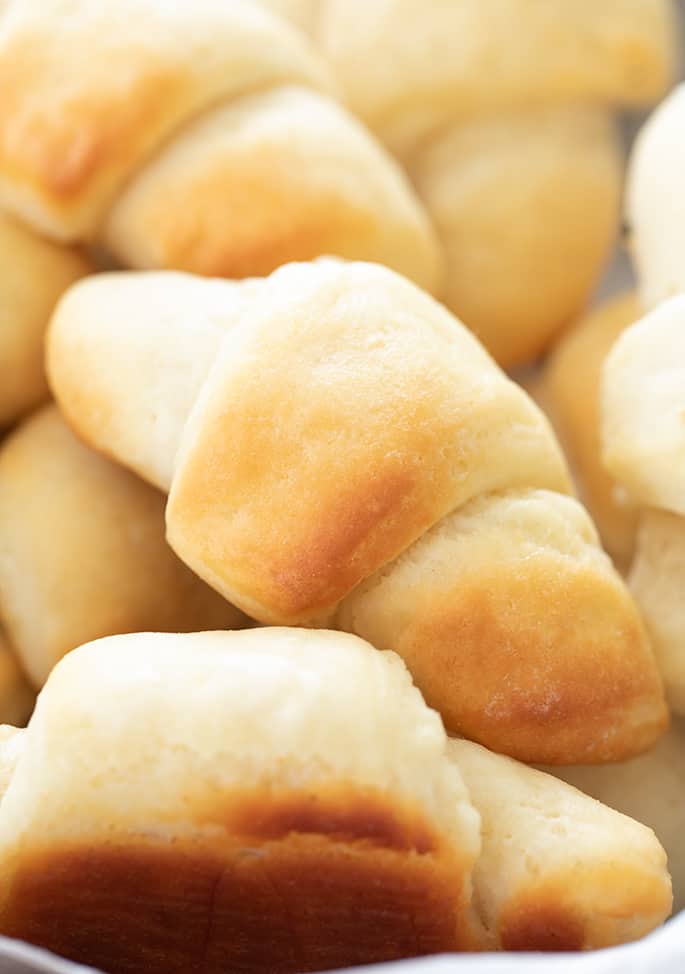
Table of Contents
- What makes this recipe for gluten free crescent rolls so special?
- FAQs
- Serving suggestions for using this soft, buttery bread gluten free crescent roll dough
- Gluten free crescent rolls: Ingredients and substitution suggestions
- The best gluten free crescent rolls recipe
- Gluten Free Crescent Rolls | Super Soft & Buttery Recipe
What makes this recipe for gluten free crescent rolls so special?
I assume you already know about the crescent rolls in the refrigerated section of nearly every grocery store in nearly every town in America. And if you haven't been gluten free your whole life, you've probably already bought that dough and used it in a bunch of interesting and fun ways.
Well, with this gluten free crescent roll dough, you can have all those recipes back along with the classic basket of buttery rolls that makes any dinner instantly better.
The dough will keep in the refrigerator, as long as it's in a tightly sealed container, for a few days. Bake the rolls on the same day you plan to serve them, preferably warm, though. Bread is always best the same day it's baked.
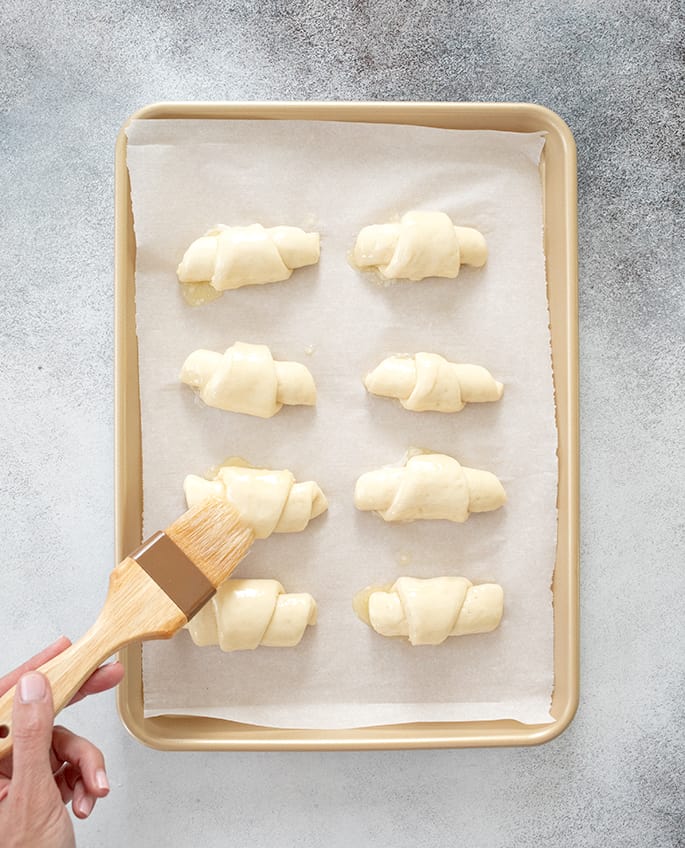
FAQs
No, crescent rolls are typically made with wheat flour, which is one of the main gluten-containing grains.
No, crescent rolls are not the same as croissants. They are similar in shape, but a crescent roll is bread, and a croissant is pastry. Croissants are like a cross between crescent rolls and flaky layered buttermilk biscuits.
You can, indeed, make gluten free croissants (we've done it!). But you'll need to work with the dough as if it were pastry, using cold ingredients and rolling and folding the dough to create light, flaky layers.
Crescent rolls are traditionally made with wheat flour, so celiacs should not eat them. This recipe, however, is developed to be made with a gluten free flour blend and all other gluten free ingredients, so it's safe for celiacs.
No, Pillsbury crescent rolls are made with enriched bleached wheat flour, which is not gluten free. Avoid these rolls on a gluten free diet.
Yes! This crescent roll dough can be used in any way you might have used Pillsbury crescent roll dough.
No, Annie's brand crescent rolls are made with wheat flour, so they aren't gluten free. Annie's does make certain gluten free products, like gluten free mac and cheese, but be careful to only buy their products that are clearly marked “gluten free,” and always read labels!
Yes, these rolls can be baked, cooled, and then frozen. You could also try parbaking the ones that you plan to freeze. Just bake them at about 300°F until they are just set but not browned at all (about 8 minutes).
Let them cool, then freeze in a single layer before piling them into a sealed freezer-safe container. When you’re ready to bake them, preheat the oven to 350°F, let them defrost almost fully at room temperature, then bake until just browned (about 10 minutes). Fresh rolls!

Serving suggestions for using this soft, buttery bread gluten free crescent roll dough
Have you ever bought a metal can of Pillsbury crescent rolls and used it to make something other than straight-up crescent rolls? In any way you may have used that dough, you can use this gluten free crescent rolls dough.
1. Ham and cheese sandwiches
Try making larger triangles by slicing each round into 6 or 8 pieces rather than 12. Then add a slice of ham and a slice of cheese to the top of the triangle before rolling it from base to tip.
Space the triangles farther apart from one another on the baking sheet. The cheese will melt onto the baking tray a bit. Just let it set a few moments after baking and before serving.
2. Cinnamon sugar rolls
Mix 1 teaspoon ground cinnamon with 1/4 cup (50 g) granulated sugar with 1 teaspoon cornstarch in a small bowl. After brushing the triangles with melted butter, sprinkle with a thin layer of the cinnamon sugar mixture.
Press the cinnamon sugar mixture down a bit to help it adhere to the melted butter on the dough. Roll from base to tip, and continue with the recipe as written.
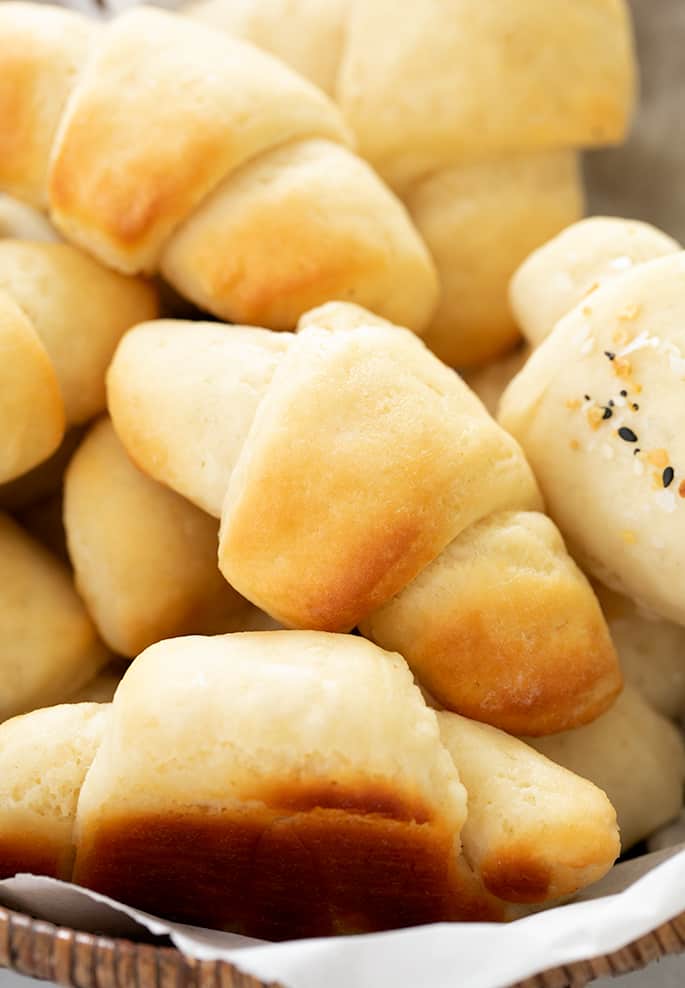
Gluten free crescent rolls: Ingredients and substitution suggestions
This recipe can't be made into gluten free dairy free crescent rolls
You can try replacing the yogurt and butter in this recipe, but the gluten free bread flour blend necessarily calls for whey protein isolate, which is nearly pure milk protein. There is no substitute for whey protein isolate that will produce the same results.
Gluten free egg free crescent rolls
There is only one egg in this recipe, so you may be able to replace it with a “chia egg” (1 tablespoon ground white chia seeds + 1 tablespoon lukewarm water, mixed and allowed to gel).
The egg yolk also adds richness, so you might want to add another tablespoon of butter to the dough and reduce the yogurt by 1 tablespoon to compensate for the added moisture.
About the yeast in these gf crescent rolls
There is no substitute for yeast in a yeast bread recipe. I do have a recipe for yeast free dinner rolls here on the blog, if you can't have yeast.
If you don't have instant yeast, as called for in the recipe, you can use 25% more active dry yeast. See the recipe notes for instructions on how to make the conversion.
The best gluten free crescent rolls recipe
Gluten Free Crescent Rolls | Super Soft & Buttery
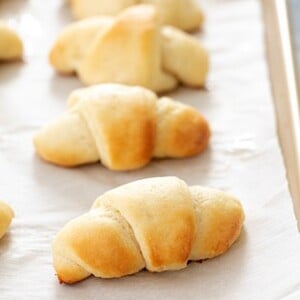
Equipment
- 1 2 liter proofing bucket or other sealed container
Ingredients
For the starter
- 1 ¼ cups (175 g) gluten free bread flour blend, (see Notes, and click thru for details on this specific blend, which must be used)
- 1 tablespoon (12 g) granulated sugar
- 1 ⅔ teaspoons (5 g) instant yeast, (see Recipe Notes)
- 1 cup (8 ounces) warm water, (about 95°F)
For the dough
- 3 ½ cups (490 g) gluten free bread flour blend, (see Notes, and click thru for details on this specific blend, which must be used), plus more for sprinkling
- 1 tablespoon (18 g) kosher salt
- 1 ½ teaspoons (11 g) honey
- ¾ cup (6 fluid ounces) buttermilk or plain whole milk yogurt, at room temperature
- 1 (50 g (weighed out of shell)) egg, at room temperature
- 3 tablespoons (42 g) unsalted butter, at room temperature
- Risen Starter
- 4 tablespoons (28 g) unsalted butter, melted (for brushing)
Instructions
Make the starter.
- In a medium-size bowl, place the bread flour, granulated sugar, and instant yeast, and whisk to combine well. Add the warm water, and mix until smooth and well-combined.
- The mixture will be thick and shapeless. Cover and set the bowl aside in a warm, draft-free location to rise until doubled in size (about 45 minutes).
Make the dough.
- In the bowl of a stand mixer, place the flour and salt, and whisk to combine well with a separate handheld whisk.
- Add the honey, yogurt or buttermilk, egg, room temperature butter, and risen starter to the bowl, and mix to combine.
- Place the bowl in your stand mixer fitted with the dough hook and knead for about 5 minutes on medium-high speed or until the dough is smooth and stretchy, and appears to have lightened a bit in color.
- Spray a silicone spatula with cooking oil spray, and scrape down the sides of the bowl. Transfer the dough to a lightly oiled bowl or proofing bucket large enough for the dough to rise to double its size, and cover tightly with oiled plastic wrap or the oiled top of your proofing bucket.
- Place the dough in the refrigerator for at least 2 hours and up to 5 days.
Shape the rolls.
- On baking day, line a rimmed baking sheet with unbleached parchment paper and set it aside.
- Turn the dough out onto a lightly floured surface, sprinkle it very lightly with more flour. Handling the dough very gently so you don’t incorporate too much flour into the dough, turn the dough over a few times until it’s smoother.
- Divide the dough into two equal portions. Set one aside and cover so it doesn’t dry out.
- Working with the remaining piece of dough, roll it into a 10-inch circle, turning the dough over frequently, sprinkling very lightly with more flour as necessary, and moving it around to prevent sticking.
- With a pizza wheel or sharp knife, slice the round of dough into 4 equal pieces, each a very wide triangle. Slice each quarter into thirds, making twelve triangles total.
- Brush the dough liberally with 2 tablespoons melted butter, then allow the dough to sit briefly to allow the butter to set.
- Repeat with the second half of the dough.
- Once the butter has begun to set, separate one triangle from the circle, and roll it gently but securely from base to tip. Place the shaped crescent roll on the prepared baking sheet, with the tip of the triangle secured on the bottom.
- Repeat with the remaining 11 triangles, spacing the rolls about 2 inches apart on the prepared baking sheet.
Let the rolls rise.
- Cover the baking sheet with lightly oiled plastic wrap, and place it in a draft-free location to rise until about 150% of its original size (30 to 45 minutes). Do not overproof.
Bake the rolls.
- About 15 minutes before the end of the rolls’ rise, preheat your oven to 350°F.
- Once the rolls have finished rising, remove the plastic wrap and brush the tops generously with more melted butter.
- Place the baking sheets in the center of the preheated oven and bake until the rolls are just browned (about 15 minutes). Remove from the oven, and serve warm.
Video
Notes
- 475 grams Better Batter original blend all purpose gluten free flour or my mock Better Batter
- 119 grams whey protein isolate
- 71 grams Expandex modified tapioca starch
Nutrition information is automatically calculated, so should only be used as an approximation.
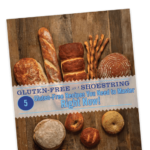

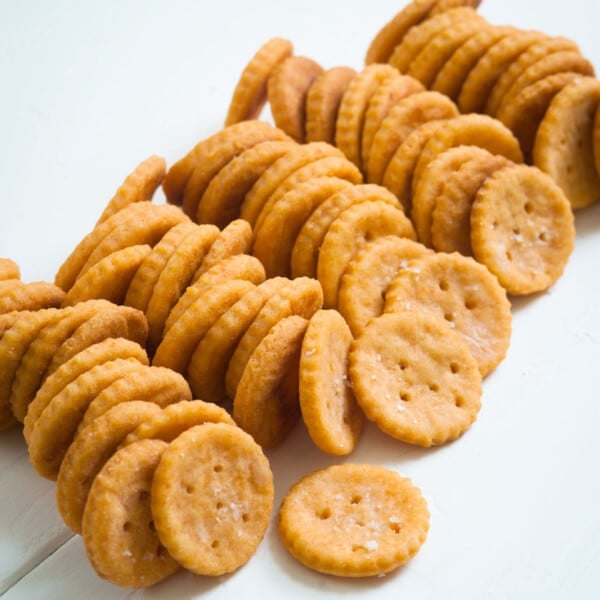
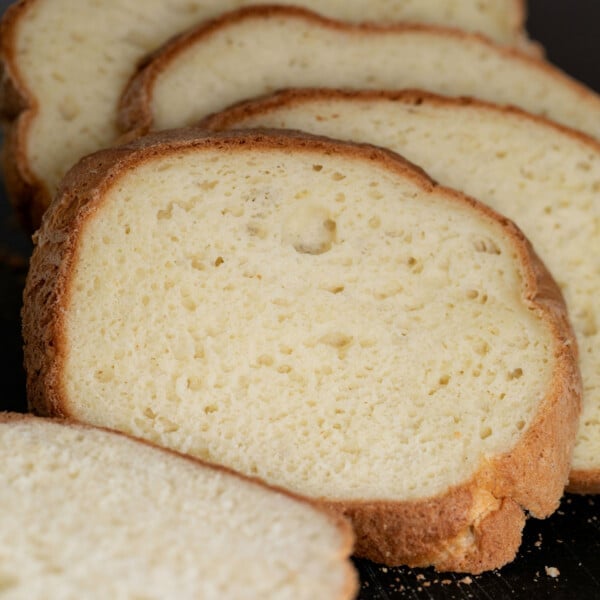
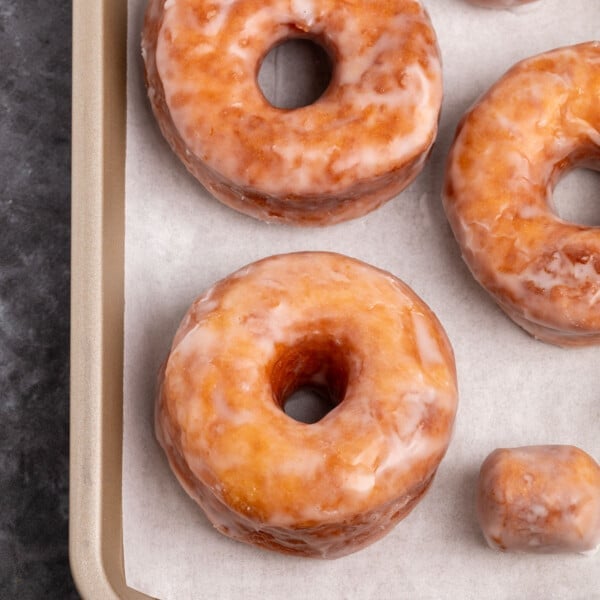
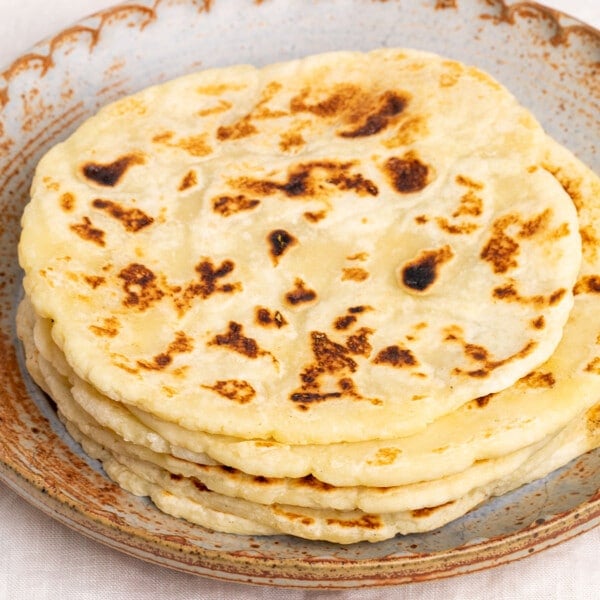









Hi! I don’t have a stand mixer. Can I knead this dough by hand? Thanks!
You definitely cannot knead it by hand. This dough requires dough hooks, for sure. If you don’t have a stand mixer, you can use a handheld mixer with dough hook attachments.
do you let the dough rise and double before you put in the fridge or do you let it rise in the fridge?
The first rise is in the refrigerator, Kathleen. I try to be very, very precise in the instructions, and would never not mention it if I expected you to let it rise first. I promise!
I made these last night and they are the first GF bread that I have made that turned out and I am SO excited! I did need a quick clarification in the instructions though…do you let the dough rise and double before you put in the fridge or do you let it rise in the fridge. I put it in the fridge to chill after mixing, but was wondering if I missed a step. Also, I used Cup4Cup flour and they turned out great! This was my trial run before Thanksgiving!
Thanks so much. It’s time to use all the ingredients I’ve acquired during COVID.
Can you recommend any other whey isolate aside from opportuniteas as its $95 per pound on Amazon Canada. Will any unflavored GF whey isolate work for bread flour? Thanks.
Whoa, Barb, that’s crazy! As long as the product is unflavored whey protein isolate, not concentrate, so around about 90% or more of each gram is milk protein, it will work fine.